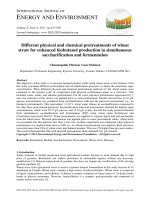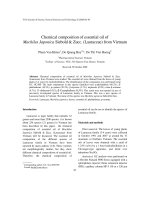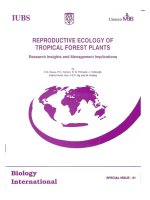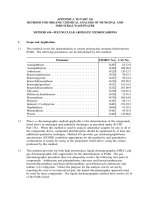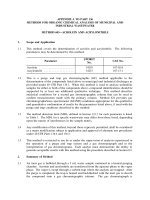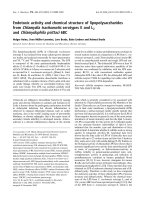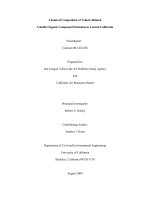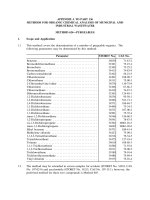chemical ecology of insect parasitoids 3edition
Bạn đang xem bản rút gọn của tài liệu. Xem và tải ngay bản đầy đủ của tài liệu tại đây (5.18 MB, 324 trang )
Chemical Ecology of Insect Parasitoids
To Maura, Eliana, Emilio and Ludovica
Chemical Ecology of
Insect Parasitoids
Edited by
Eric Wajnberg
Institut National de la Recherche Agronomique (INRA)
Sophia Antipolis Cedex
France
and
Stefano Colazza
Department of Agricultural and Forest Sciences
University of Palermo
Palermo
Italy
A John Wiley & Sons, Ltd., Publication
This edition first published 2013 © 2013 by John Wiley & Sons, Ltd.
Wiley-Blackwell is an imprint of John Wiley & Sons, formed by the merger of Wiley’s global Scientific,
Technical and Medical business with Blackwell Publishing.
Registered office: John Wiley & Sons, Ltd, The Atrium, Southern Gate, Chichester, West Sussex, PO19
8SQ, UK
Editorial offices: 9600 Garsington Road, Oxford, OX4 2DQ, UK
The Atrium, Southern Gate, Chichester, West Sussex, PO19 8SQ, UK
111 River Street, Hoboken, NJ 07030-5774, USA
For details of our global editorial offices, for customer services and for information about how to apply
for permission to reuse the copyright material in this book please see our website at www.wiley.com/
wiley-blackwell.
The right of the author to be identified as the author of this work has been asserted in accordance with
the UK Copyright, Designs and Patents Act 1988.
All rights reserved. No part of this publication may be reproduced, stored in a retrieval system, or
transmitted, in any form or by any means, electronic, mechanical, photocopying, recording or otherwise,
except as permitted by the UK Copyright, Designs and Patents Act 1988, without the prior permission
of the publisher.
Designations used by companies to distinguish their products are often claimed as trademarks. All brand
names and product names used in this book are trade names, service marks, trademarks or registered
trademarks of their respective owners. The publisher is not associated with any product or vendor
mentioned in this book.
Limit of Liability/Disclaimer of Warranty: While the publisher and author(s) have used their best efforts
in preparing this book, they make no representations or warranties with respect to the accuracy or
completeness of the contents of this book and specifically disclaim any implied warranties of
merchantability or fitness for a particular purpose. It is sold on the understanding that the publisher is
not engaged in rendering professional services and neither the publisher nor the author shall be liable
for damages arising herefrom. If professional advice or other expert assistance is required, the services of
a competent professional should be sought.
Library of Congress Cataloging-in-Publication Data
Chemical ecology of insect parasitoids / edited by Eric Wajnberg and Stefano Colazza.
pages cm
Includes bibliographical references and index.
ISBN 978-1-118-40952-7 (cloth)
1. Semiochemicals. 2. Plant chemical ecology. 3. Parasitoids. 4. Plant parasites. 5. Insect-plant
relationships. I. Wajnberg, E. II. Colazza, Stefano.
SB933.5.C47 2013
632'.7–dc23
2012049864
A catalogue record for this book is available from the British Library.
Wiley also publishes its books in a variety of electronic formats. Some content that appears in print may
not be available in electronic books.
Cover image: A parasitoid wasp (Cotesia vestalis) and a diamondback moth (Plutella xylostella) larva on
a broccoli leaf. Photograph courtesy of Jarmo Holopainen. The molecule pictured on the right is
4-methylquinazoline, and the molecule on the left is (4R,5S)-5-hydroxy-4-decanolide.
Cover design by Steve Thompson
Set in 10/12.5 pt Minion by Toppan Best-set Premedia Limited
1 2013
Contents
Contributors
xi
1
1
Chemical ecology of insect parasitoids: towards a new era
Stefano Colazza and Eric Wajnberg
Abstract
1.1 Introduction
1.2 Integrating behavioural ecology and chemical ecology in insect
parasitoids
1.3 The use of chemical ecology to improve the efficacy of insect
parasitoids in biological control programmes
1.4 Overview
1.5 Conclusions
Acknowledgements
References
Part 1 Basic concepts
2
Plant defences and parasitoid chemical ecology
Paul J. Ode
Abstract
2.1 Introduction
2.2 Plant defences against a diversity of attackers
2.2.1 Plant defence signalling pathways
2.2.2 Plant volatiles and parasitoids
2.2.3 Plant toxins and parasitoids
2.2.4 Cross-talk between plant defence pathways
2.3 Above-ground–below-ground interactions and parasitoids
2.4 Climate change and parasitoid chemical ecology
2.5 Conclusions
Acknowledgements
References
1
1
3
4
5
6
6
7
9
11
11
12
13
13
16
18
21
24
25
28
28
28
vi
3
4
5
CONTENTS
Foraging strategies of parasitoids in complex chemical environments
Nicole Wäschke, Torsten Meiners and Michael Rostás
Abstract
3.1 Introduction
3.2 Chemical complexity
3.2.1 Plant species diversity and habitat location
3.2.2 Variability in host plant traits and their effects on parasitoid
host location
3.3 Foraging strategies of parasitoids in chemically complex environments
3.3.1 Behavioural responses to chemical complexity
3.3.2 Learning, sensory filters and neural constraints affecting
strategies for dealing with complexity
3.3.3 Influences of life history traits on foraging strategy
3.4 Conclusions
References
Chemical ecology of insect parasitoids in a multitrophic above- and
below-ground context
Roxina Soler, T. Martijn Bezemer and Jeffrey A. Harvey
Abstract
4.1 Introduction
4.2 Influence of root feeders on above-ground insect herbivores
4.3 Influence of soil-borne symbionts on above-ground insect herbivores
4.4 Plant-mediated effects of root feeders and soil-borne symbionts
on growth and development of parasitoids
4.5 Effects of root-feeding insects on HIPVs and host location of
parasitoids
4.6 Expanding an above–below-ground bitrophic reductionist perspective
Acknowledgement
References
A hitch-hiker’s guide to parasitism: the chemical ecology of phoretic insect
parasitoids
Martinus E. Huigens and Nina E. Fatouros
Abstract
5.1 Phoresy
5.2 Prevalence of phoretic parasitoids
5.3 Important parasitoid and host traits
5.3.1 Parasitoid traits
5.3.2 Host traits
5.4 Chemical espionage on host pheromones
5.4.1 Espionage on male aggregation pheromone
5.4.2 Espionage on sex pheromones
5.4.3 Espionage on anti-sex pheromones
5.5 Coevolution between phoretic spies and hosts
5.6 Biological control
37
37
37
40
40
42
48
48
50
51
53
54
64
64
65
67
69
70
74
76
79
79
86
86
87
87
90
90
92
93
93
98
99
100
103
CONTENTS
5.7 Future perspectives
Acknowledgements
References
6
7
8
Novel insights into pheromone-mediated communication in parasitic
hymenopterans
Joachim Ruther
Abstract
6.1 Introduction
6.2 Pheromones and sexual behaviour
6.2.1 Volatile sex attractants
6.2.2 Female-derived courtship pheromones
6.2.3 Male-derived courtship pheromones
6.3 Other pheromones
6.3.1 Marking pheromones
6.3.2 Putative alarm and appeasement pheromones
6.3.3 Aggregation pheromones
6.3.4 Anti-aggregation pheromones
6.4 Variability in pheromone-mediated sexual behaviour
6.4.1 Innate plasticity of pheromone behaviour
6.4.2 Learnt plasticity of pheromone behaviour
6.4.3 Plasticity of pheromone behaviour caused by abiotic factors
6.5 Pheromone biosynthesis
6.6 Evolution of parasitoid sex pheromones
6.7 Conclusions and outlook
References
vii
103
104
105
112
112
113
119
119
124
127
128
128
129
130
130
131
131
131
132
132
133
135
136
Chemical ecology of tachinid parasitoids
Satoshi Nakamura, Ryoko T. Ichiki and Yooichi Kainoh
Abstract
7.1 Introduction
7.2 Long-range orientation
7.2.1 Long-range orientation by direct type parasitoids
7.2.2 Long-range orientation by indirect type parasitoids
7.2.3 Host pheromones used by direct type parasitoids
7.3 Short-range orientation
7.3.1 Short-range orientation by direct type parasitoids
7.3.2 Short-range orientation by indirect type parasitoids
7.4 Conclusions
Acknowledgements
References
145
Climate change and its effects on the chemical ecology of insect parasitoids
Jarmo K. Holopainen, Sari J. Himanen and Guy M. Poppy
Abstract
8.1 On climate change and chemical ecology
8.2 Direct climate change impacts on parasitoids
168
145
146
155
155
157
158
159
159
161
163
163
164
168
169
171
viii
CONTENTS
8.3
Climate change and bottom-up impacts on parasitoids: herbivore host
and plant host quality
8.4 Impacts of climate change-related abiotic stresses on parasitoid
ecology and behaviour
8.4.1 Impacts of elevated temperature
8.4.2 Precipitation and drought
8.4.3 Gaseous reactive air pollutants
8.4.4 Atmospheric CO2 concentration
8.4.5 Parasitoid response to combined abiotic stresses
8.5 Climate change impacts on biological control
8.6 Ecosystem services provided by parasitoids: impact of changing
climate
8.7 Future research directions and conclusions
References
Part 2 Applied concepts
9
Chemical ecology of insect parasitoids: essential elements for developing
effective biological control programmes
Torsten Meiners and Ezio Peri
Abstract
9.1 Introduction
9.2 Essential elements in parasitoid chemical ecology
9.3 Manipulation of the population levels of natural enemies by
semiochemicals
9.4 Limits and perspectives of behavioural manipulation of parasitoids by
applying semiochemicals
9.5 Cautionary example: interspecific competitive interactions in
parasitoids
9.6 Conclusions
References
10 The application of chemical cues in arthropod pest management for
arable crops
Maria Carolina Blassioli-Moraes, Miguel Borges and Raul Alberto Laumann
Abstract
10.1 Arable crops: characteristics of the systems and trophic interactions
mediated by chemical cues
10.2 Methodologies for using chemical cues to attract and retain
parasitoids in arable crops
10.2.1 Direct application of semiochemicals
10.2.2 Environmental manipulation
10.3 Final considerations
Acknowledgements
References
172
175
175
176
177
179
180
181
182
184
185
191
193
193
194
196
201
204
210
212
213
225
225
226
227
228
236
237
239
239
CONTENTS
11 Application of chemical cues in arthropod pest management for orchards and
vineyards
Stefano Colazza, Ezio Peri and Antonino Cusumano
Abstract
11.1 Introduction
11.2 Pheromone-based tactics in orchards and vineyards
11.2.1 Host sex pheromones
11.2.2 Parasitoid pheromones
11.3 Allelochemical-based manipulation in orchards and vineyards
11.3.1 Herbivore-induced plant volatiles (HIPVs)
11.3.2 Host-associated volatiles (HAVs)
11.4 Conclusions
Acknowledgement
References
12 Application of chemical cues in arthropod pest management for organic crops
Marja Simpson, Donna M.Y. Read and Geoff M. Gurr
Abstract
12.1 Introduction: organic farming and compatibility of chemical cues
12.2 Overview of plant defences involving plant volatiles
12.3 The use of synthetic HIPVs in pest management
12.4 Arthropod pest management strategies used in organic farming
12.5 Potential for extending chemical cue use in organic systems
12.6 Conclusions
References
ix
245
245
246
247
247
248
249
249
257
260
261
261
266
266
267
268
269
273
275
277
277
13 Application of chemical cues in arthropod pest management for forest trees
Timothy D. Paine
Abstract
13.1 Forest insect herbivores and natural enemy host/prey finding
13.2 Introduction to forest systems
13.3 Examples from North America
13.3.1 Native bark beetles in plantation and unmanaged forests
13.3.2 Introduced defoliator in urban and unmanaged forests
13.3.3 Introduced wood borer in plantation and urban environments
13.4 Conclusions
References
282
Index
296
282
283
285
287
287
288
289
290
291
Contributors
T. Martijn Bezemer
Department of Terrestrial Ecology
Netherlands Institute of Ecology (NIOO-KNAW)
P.O. Box 50
6700 AB Wageningen
The Netherlands
Maria Carolina Blassioli-Moraes
Embrapa
Genetic Resources and Biotechnology
Caixa Postal 02372
70770-917 Brasília-DF
Brazil
Miguel Borges
Embrapa
Genetic Resources and Biotechnology
Caixa Postal 02372
70770-917 Brasília-DF
Brazil
Stefano Colazza
Department of Agricultural and Forest Sciences
University of Palermo
Viale delle Scienze, 13
90128 Palermo
Italy
Antonino Cusumano
Department of Agricultural and Forest Sciences
University of Palermo
Viale delle Scienze, 13
90128 Palermo
Italy
xii
CONTRIBUTORS
Nina E. Fatouros
Wageningen University
Laboratory of Entomology
Department of Plant Sciences
PO Box 8031
6700 EH Wageningen
The Netherlands
Geoff M. Gurr
E.H. Graham Centre for Agricultural Innovation
NSW Department of Primary Industries and Charles Sturt University
P.O. Box 883
Orange, NSW, 2800
Australia
Jeffrey A. Harvey
Department of Terrestrial Ecology
Netherlands Institute of Ecology (NIOO-KNAW)
P.O. Box 50
6700 AB Wageningen
The Netherlands
Sari J. Himanen
MTT Agrifood Research Finland
Plant Production Research
Lönnrotinkatu 5
50100 Mikkeli
Finland
Jarmo K. Holopainen
Department of Environmental Science
University of Eastern Finland
P.O. Box 1627
70211 Kuopio
Finland
Martinus E. Huigens
Dutch Butterfly Conservation
PO Box 506
6700 AM Wageningen
The Netherlands
Ryoko T. Ichiki
Japan International Research Centre for Agricultural Sciences
Owashi
Tsukuba
Ibaraki 305-8686
Japan
CONTRIBUTORS
Yooichi Kainoh
Faculty of Life and Environmental Sciences
University of Tsukuba
Tsukuba
Ibaraki 305-8572
Japan
Raul Alberto Laumann
Embrapa
Genetic Resources and Biotechnology
Caixa Postal 02372
70770-917 Brasília-DF
Brazil
Torsten Meiners
Freie Universität Berlin
Department of Applied Zoology/Animal Ecology
Haderslebener Str. 9
12163 Berlin
Germany
Satoshi Nakamura
Japan International Research Centre for Agricultural Sciences
Owashi
Tsukuba
Ibaraki 305-8686
Japan
Paul J. Ode
Colorado State University
Department of Bioagricultural Sciences and Pest Management
Fort Collins, CO 80523-1177
USA
Timothy D. Paine
University of California, Riverside
Department of Entomology
Riverside, CA 92521
USA
Ezio Peri
Department of Agricultural and Forest Sciences
University of Palermo
Viale delle Scienze, 13
90128 Palermo
Italy
xiii
xiv
CONTRIBUTORS
Guy M. Poppy
Centre for Biological Sciences
Building 85
University of Southampton
Highfield Campus
Southampton SO17 1BJ
UK
Donna M.Y. Read
School of Agriculture and Wine Science
Charles Sturt University
P.O. Box 883
Orange, NSW, 2800
Australia
Michael Rostás
Bio-Protection Research Centre
PO Box 84
Lincoln University 7647
Canterbury
New Zealand
Joachim Ruther
Institute of Zoology
Chemical Ecology Group
University of Regensburg
Universitätsstrasse 31
93053 Regensburg
Germany
Marja Simpson
E.H. Graham Centre for Agricultural Innovation
NSW Department of Primary Industries and Charles Sturt University
P.O. Box 883
Orange, NSW, 2800
Australia
Roxina Soler
Department of Terrestrial Ecology
Netherlands Institute of Ecology (NIOO-KNAW)
P.O. Box 50
6700 AB Wageningen
The Netherlands
CONTRIBUTORS
Eric Wajnberg
INRA
400 Route des Chappes
BP 167
06903 Sophia Antipolis Cedex
France
Nicole Wäschke
Freie Universität Berlin
Department of Applied Zoology/Animal Ecology
Haderslebener Str. 9
12163 Berlin
Germany
xv
1
Chemical ecology of insect parasitoids:
towards a new era
Stefano Colazza1 and Eric Wajnberg2
1
Department of Agricultural and Forest Sciences, University of Palermo, Italy
INRA, Sophia Antipolis Cedex, France
2
Abstract
Over the course of evolutionary time, insect parasitoids have developed diverse
strategies for using chemical compounds to communicate with various protagonists within their environment (i.e. conspecifics, their hosts, and the plants
on which their hosts are living). Unravelling the evolutionary meaning of such
chemical communication networks not only provides new insights into the
ecology of these insects but also contributes to improving the use of parasitoids
for the control of insect pests in biological control programmes. A book covering
our current knowledge of the chemical ecology of insect parasitoids is therefore
particularly timely and will appeal to a large number of potential readers worldwide, from university students to senior scientists. Internationally recognized
specialists were invited to contribute chapters to this book, examining the main
topics and exploring the most interesting issues in the field of chemical ecology
of insect parasitoids. The chapters are organized so as to present the most
significant knowledge and discoveries made over recent decades, and their
potential uses in pest control.
1.1 Introduction
For several million years, plants, insects and their natural enemies have coevolved on the
basis of information flows within food webs (Krebs & Davies 1987). As a consequence, they
were – and still are – continuously exposed to selection pressures which drive evolution
according to a process referred to as an ‘arms race’ (Dawkins & Krebs 1979). Different
ecological features of interacting species can evolve in response to selection pressures,
leading species and their populations to evolve and improve their reproductive success.
Chemical Ecology of Insect Parasitoids, First Edition. Eric Wajnberg and Stefano Colazza.
© 2013 John Wiley & Sons, Ltd. Published 2013 by John Wiley & Sons, Ltd.
2
STEFANO COLAZZA AND ERIC WAJNBERG
Most of the time, such responses cause individuals to react more effectively to signals
coming from their biotic and abiotic environment. Among the different types of signals
that can influence these ecological interactions, chemical cues, called semiochemicals (from
the Greek ‘semeion’, a mark or signal), play the major role (Nordlund 1981, Vinson 1985,
Vet & Dicke 1992). These compounds can be classified into two groups, named pheromones and allelochemicals.
Pheromones (from the Greek ‘pherein’, to carry, and ‘horman’, to excite or stimulate) are
chemical signals that mediate interactions between individuals of the same species, and
they are often described on the basis of their function (Wyatt 2010). Since their discovery,
many pheromones have been identified and synthesized and a number of techniques have
been developed to use them in Integrated Pest Management (IPM) programmes against
insect pests (Ridgway et al. 1990). In particular, pheromones are widely used in IPM to
monitor insect pest populations and to interfere with their behaviour, thus reducing or
preventing agricultural damage (Witzgall et al. 2010). On the other hand, signals that
operate interspecifically (between different species) are termed ‘allelochemicals’ and may
be called synomones, kairomones or allomones, depending on their ecological and biological functions (Dicke & Sabelis 1988, Ruther et al. 2002).
The study of the ecological functions of semiochemicals is the main subject of chemical
ecology (Ruther et al. 2002, Eisner 2003, Bergstrom 2007, Colazza et al. 2010, WortmanWunder & Vivanco 2011). In the past two decades, a plethora of studies have demonstrated
the importance of chemical cues for ecological processes at the individual, population and
ecosystem levels (Takken & Dicke 2006). However, although there have been considerable
advances in understanding, there are still many critical questions that lack answers (Meinwald & Eisner 2008). The new possibilities offered by genomic and proteomic tools will
undoubtedly result in increased understanding over the coming years (Kessler & Baldwin
2002, Vermeer et al. 2011).
Parasitoids represent fascinating model organisms for evolutionary and ecological
studies because of their species richness, ecological impact and economic importance
(Godfray 1994, Wajnberg et al. 2008). They belong mainly to two orders, Hymenoptera
and Diptera. Within the Hymenoptera, there are about 45 families containing parasitoids.
Within the Diptera, most species of parasitoids occur in the family Tachinidae.
Evidence that semiochemicals can modify the behaviour of insect natural enemies has
inspired researchers to explore the possibility of using semiochemicals to conserve and/or
enhance the efficacy of natural enemies in cropping systems (Pickett et al. 1997, Khan
et al. 2008). However, the use of semiochemicals integrated with natural enemies in IPM
is still limited, despite the fact that important research has been done in recent years to
elucidate the interactions between semiochemicals and natural enemies in a multitrophic
context (see Soler, Bezemer & Harvey, Chapter 4, this volume).
During the last few decades, many studies have investigated the chemically mediated
foraging behaviour of parasitoids in an attempt to understand the factors that guide parasitoids to their hosts. In order to provide a quantitative overview of this work, a literature
survey was performed. This consisted of interrogating the Scopus database using the term
‘parasitoids’. In total, we obtained 10,463 references published within the period 1935–2011
(about 140 papers published per year). Among these, 458 (i.e. 4.38%) also used the terms
‘synomone’, ‘kairomone’ and/or ‘allomone’. Figure 1.1 summarizes the cumulative number
of references published over the years and the frequency of the use of the terms ‘synomone’,
‘kairomone’ and/or ‘allomone’.
800
50
40
600
30
400
20
200
0
10
1940 1950 1960 1970 1980 1990 2000 2010
Year
0
3
Percentage dealing with semiochemicals
CHEMICAL ECOLOGY OF INSECT PARASITOIDS: TOWARDS A NEW ERA
Number of references on parasitoids
Figure 1.1 Changes in the number of references found in the Scopus abstracts and
citations database for the period 1935–2011, using the term ‘parasitoids’ (line with
dots) and the frequency of those that also used the terms ‘synomone’, ‘kairomone’
and/or ‘allomone’ (line without dots).
From about the mid-1970s onwards there has been an increasing interest in publishing
papers dealing with parasitoids, coupled with a tendency to focus on chemical ecology.
After about a decade, the frequency of papers using the words ‘synomone’, ‘kairomone’ and/
or ‘allomone’ stabilized at around 4.4%. The most likely reason for this is not so much a
decline in interest in the chemical ecology of these model animals, but an increase in interest in other aspects of the biology and ecology of parasitoids, for example behavioural
ecology (see below). In other words, there was – and still is – a constant interest in understanding the mechanisms involved in the way that insect parasitoids produce and use
chemical compounds to communicate with the various different protagonists within their
environment (i.e. conspecifics, their hosts, and the plants on which their hosts are living).
Unravelling the evolutionary meaning of such a chemical communication network can
provide new insights into the ecology of these insects, and especially on how to improve
their use for the control of harmful pests in biological control programmes. Therefore, a
book covering the current state of knowledge on the chemical ecology of insect parasitoids
seems particularly timely and capable of appealing to a large number of potential readers
worldwide.
1.2 Integrating behavioural ecology and chemical ecology in insect parasitoids
In 2008, Wajnberg et al. (2008) edited a book on the behavioural ecology of insect parasitoids covering cutting-edge research into decision-making processes in insect parasitoids
and their implications for biological control. The goal of behavioural ecology is to understand the behavioural decisions adopted by animals to maximize their long-term reproductive success, and for this research theoretical maximization models are frequently
used. We visualize this current book on the chemical ecology of insect parasitoids as a
4
STEFANO COLAZZA AND ERIC WAJNBERG
complementary volume to Wajnberg et al. (2008), extending our understanding and
knowledge of insect parasitoids and their use for controlling pests in biological control
programmes. After all, chemical ecology – and especially that of insect parasitoids – and
behavioural ecology are both based on the accurate observation and analysis of animal
behaviour, and the final goal of both volumes is to find ways to improve the efficacy of
these insects in controlling pests and protecting crops.
Research efforts in chemical ecology have mainly been based on the development of
chemical tools (i) to identify the chemical compounds involved in the way in which insect
parasitoids interact with their environment, both at the intra- and interspecific levels; (ii)
to understand the associated metabolic pathways; and (iii) to synthesize these compounds
for use in enhancing pest control strategies through field-release applications. Such a
chemical-based approach has resulted in a rapid improvement in understanding over the
past decades, as can be seen in the different chapters within this book. However, we think
that it has also precluded the development of theoretical research that aims to understand
the optimal decision-making strategy that should be adopted by these insects in terms of
releasing and/or perceiving chemical signals in their environment. The fact is that insect
parasitoids have been subjected to extreme evolutionary pressure, over the course of time,
to use such chemical tools and there are obviously cost/benefit ratio issues that need to be
optimized in order to increase the ability of these animals to contribute genetically to the
following generations.
The reason that such a theoretical approach has not yet been sufficiently developed, in
our view, is most probably because the chemical ecology community mainly consists of
scientists who have more expertise in chemistry than in theoretical ecology. There are,
however, a handful of studies that have used optimality models to illustrate the chemical
ecology of insect parasitoids. For example, Hoffmeister & Roitberg (1998) developed a
theoretical model to identify the optimal persistence duration (or decay rate) of a contact
pheromone used by a herbivorous insect to signal the presence of its own eggs to both
the marking female and conspecifics. The point is that this pheromone is also exploited
by a specialized parasitoid that attacks the herbivore’s offspring, so there is an evolutionary game being played between needing to signal the presence of eggs to conspecific
females while avoiding their detection by parasitoids. The approach developed by these
authors effectively takes into account the physiological costs associated with the marking
strategy. Examples like this are still rare, and one goal of the present volume is to foster
research in this area, bridging the gap between the behavioural and chemical ecology
of insect parasitoids, with the final aim of developing more efficient biological control
programmes.
1.3 The use of chemical ecology to improve the efficacy of insect parasitoids
in biological control programmes
In recent years, significant progress in understanding insect behaviour and advances in
analytical chemistry have led to the identification and production of thousands of semiochemical compounds. Important research has been conducted to investigate how these
compounds can be used commercially, and many of them are now contributing to established practices in Integrated Pest Management (IPM) (Suckling & Karg 2000, Witzgall
et al. 2010). In this respect, an increasing knowledge of the influence of semiochemicals
CHEMICAL ECOLOGY OF INSECT PARASITOIDS: TOWARDS A NEW ERA
5
on parasitoid and predator behaviour has opened up new possibilities in pest control
strategy.
Semiochemical-based manipulations normally include either ‘pheromone-based tactics’
or ‘allelochemical-based tactics’. Pheromone-based tactics now represent one of the major
strategies in ecologically based orchard pest management, leading to considerable success
in both direct and indirect insect pest control. The most successful applications for the
direct control of pest populations concern the release of sex pheromones to disrupt mating
in the target pests (Witzgall et al. 2010). In contrast, allelochemical-based tactics represent
a relatively new approach that mainly uses plant volatiles. The most promising application
of allelochemical-based tactics involves the use of herbivore-induced plant volatiles (HIPVs)
to manipulate the natural enemies of the pest species in order to attract and conserve them
in the vicinity of the crops to be protected. HIPVs are semiochemicals that mediate many
multitrophic interactions in both above- and below-ground plant–insect communities
(Soler et al. 2007, Soler, Bezemer & Harvey, Chapter 4, this volume). These volatiles have
received increased attention for their role in attracting natural enemies of insect pests (Ode,
Chapter 2, this volume). In the last decade, the results of several field experiments have
been published demonstrating that the release of HIPVs can indeed augment, conserve or
enhance the efficacy of natural enemies. However, allelochemical-based tactics, especially
based on the use of HIPVs, are lagging far behind the development of applications of
pheromones. In this respect, it has to be noted that genetically modified plants have recently
been shown to provide new opportunities for semiochemical applications. For example,
plants can be engineered to produce (E)-β-farnesene to mimic the natural aphid alarm
response in order to increase foraging by aphid predators and parasitoids (Yu et al. 2012).
1.4 Overview
Remarkable advances in our understanding of the chemical ecology of insect parasitoids
have occurred in recent years. In this book, we have assembled papers written by internationally recognized experts who are at the forefront of their field. The chapters are organized in order to present the most important knowledge and discoveries made over the past
few decades, and on their potential use in pest control strategy. In addition to this introductory chapter, the book contains 12 chapters, organized into two parts. The first part
addresses the basic aspects of parasitoid behaviour, and the second focuses on possible
strategies for manipulating the behaviour of insect parasitoids to increase their pest control
ability by means of chemical cues in different ecosystems and under different agricultural
practices. Specific relevant case studies are also presented.
The first part of the book starts with a chapter focusing on plant defence responses to
a diversity of pests and abiotic stressors, and their effects on insect parasitoids (Chapter 2).
Plants are indeed an important component of the foraging environment of insect parasitoids, orchestrating the presence of complex signalling networks available to these insects.
This is the topic addressed by the following chapter, which considers in detail the role of
volatile and non-volatile compounds, coupled with biotic and abiotic factors, in shaping
the variability of these chemicals in both time and space (Chapter 3).
Chemical signals are not only relevant at the above-ground level. There are also signals at the below-ground level that are involved in structuring the ecology of plant–
insect interactions. Understanding the role played by these different signals requires a
6
STEFANO COLAZZA AND ERIC WAJNBERG
multitrophic approach, and that is what is discussed in the following chapter (Chapter 4).
Chemical signals are also used by phoretic insect parasitoids that ‘hitch-hike’ on hosts in
order to increase access to potential hosts to attack. Several important and fascinating
studies have been carried out on this topic, which is addressed in Chapter 5. In the past
decade, astonishing progress has been made to further our understanding of pheromonemediated communication in parasitic wasps, especially for mate finding and recognition,
aggregation, or host-marking behaviour, and this is presented in Chapter 6. The two remaining chapters of the first part of the book address the particular case of dipteran tachinid species that demonstrate oviposition strategies which differ from those adopted by
hymenopteran wasps (Chapter 7), and the potential consequences of climate change on
the chemical ecology of insect parasitoids in general (Chapter 8).
The second part of this book focuses on applications for biological control. The first
chapter (Chapter 9) starts by providing a detailed overview of how semiochemicals
can be used to manipulate the foraging behaviour of insect parasitoids in order to
increase their impact on pest populations. This can be done either through facilitating
their ability to locate and attack their hosts, or by increasing their recruitment within
agroecosystems. The following chapters then address the application of chemical cues for
enhancing the pest control efficacy of parasitic wasps in arable crops (Chapter 10),
orchards and vineyards (Chapter 11), organic cropping systems (Chapter 12) and forest
trees (Chapter 13).
1.5 Conclusions
This book is intended for anyone interested in understanding how insects, and parasitic
wasps in particular, use chemical compounds to communicate with others and to discover
resources to exploit. The book will be of interest to research scientists and their students
working in the academic world (research centres and universities) and also to teachers in
graduate schools and universities that teach insect chemical ecology. Furthermore, the
background information gathered together in this book could be used to encourage highschool students and stimulate research in the field of chemical ecology of insect parasitoids.
Biological control practitioners will also find the technical information needed to improve
pest control efficacy through the release of insect parasitoids in the field.
Throughout the book, critical research questions are explicitly identified, acknowledging
the gaps in current knowledge. Ultimately, the goal of the book is to foster synergistic
research that will eventually lead to a better understanding of the fields of chemical and
behavioural ecology of parasitic wasps.
Acknowledgements
We thank Antonino Cusumano for assistance in interrogating the Scopus database, and
Helen Roy and Ezio Peri for critical comments on this chapter. We also wish to thank the
referees who read and commented critically on one or more chapters. They include Miguel
Borges, Stefano Colazza, Jeff Harvey, Jarmo Holopainen, Martinus Huigens, Yooichi Kainoh,
Jocelyn Millar, Satoshi Nakamura, Paul Ode, Tim Paine, Ezio Peri, Guy Poppy, Michael
Rostás, Helen Roy, Joachim Ruther, Roxina Soler and Eric Wajnberg. Finally, we express
CHEMICAL ECOLOGY OF INSECT PARASITOIDS: TOWARDS A NEW ERA
7
our sincere thanks to the staff at Wiley-Blackwell for their excellent help and support
during the production of this book.
Although much editing work has been done, the information provided within each
chapter remains the sole responsibility of the individual authors.
References
Bergstrom, G. (2007) Chemical ecology = chemistry + ecology! Pure and Applied Chemistry 79:
2305–23.
Colazza, S., Peri, E., Salerno, G. and Conti, E. (2010) Host searching by egg parasitoids: exploitation
of host chemical cues. In: Cônsoli, F.L., Parra, J.R.P. and Zucchi, R.A. (eds) Egg Parasitoids in Agroecosystems with Emphasis on Trichogramma. Springer, Dordrecht, pp. 97–147.
Dawkins, R. and Krebs, J. (1979) Arms races between and within species. Proceedings of the Royal
Society of London B 205: 489–511.
Dicke, M. and Sabelis, M.W. (1988) Infochemical terminology: based on cost–benefit analysis rather
than origin of compounds. Functional Ecology 2: 131–9.
Eisner, T. (2003) Chemical ecology: can it survive without natural products chemistry? Proceedings
of the National Academy of Sciences USA 100: 14517–8.
Godfray, H.C.J. (1994) Parasitoids: Behavioural and Evolutionary Ecology. Princeton University Press,
Princeton, NJ.
Hoffmeister, T.S. and Roitberg, B.D. (1998) Evolution of signal persistence under predator exploitation. Ecoscience 5: 312–20.
Kessler, A. and Baldwin, I.T. (2002) Plant responses to insect herbivory: The emerging molecular
analysis. Annual Review of Plant Biology 53: 299–328.
Khan, Z.R., James, D.G., Midega, C.A.O. and Pickett, C.H. (2008) Chemical ecology and conservation
biological control. Biological Control 45: 210–24.
Krebs, J.R. and Davies, N.B. (1987) An Introduction to Behavioural Ecology. Blackwell Publishing Ltd.,
Oxford.
Meinwald, J. and Eisner, T. (2008) Chemical ecology in retrospect and prospect. Proceedings of the
National Academy of Sciences USA 105: 4539–40.
Nordlund, D.A. (1981) Semiochemicals: a review of the terminology. In: Nordlund, D.A., Jones, R.J.
and Lewis, W.J. (eds) Semiochemicals: Their Role in Pest Control. John Wiley & Sons, New York,
pp. 13–28.
Pickett, J.A., Wadhams, L.J. and Woodcock, C.M. (1997) Developing sustainable pest control from
chemical ecology. Agriculture, Ecosystems and Environment 64: 149–56.
Ridgway, R.L., Silverstein, R.M. and Inscoe, M.N. (1990) Behavior-Modifying Chemicals for Insect
Management: Applications of Pheromones and other Attractants. Marcel Dekker, New York.
Ruther, J., Meiners, T. and Steidle, J.L.M. (2002) Rich in phenomena – lacking in terms: a classification of kairomones. Chemoecology 12: 161–7.
Soler, R., Harvey, J.A. and Bezemer, T.M. (2007) Foraging efficiency of a parasitoid of a leaf herbivore
is influenced by root herbivory on neighbouring plants. Functional Ecology 21: 969–74.
Suckling, D.M. and Karg, G. (2000) Pheromones and semiochemicals. In: Rechcigl, J. and Rechcigl,
N. (eds) Biological and Biotechnical Control of Insect Pests. CRC Press, Boca Raton, FL, pp. 63–99.
Takken, W. and Dicke, M. (2006) Chemical ecology: a multidisciplinary approach. In: Dicke, M. and
Takken, W. (eds) PhD Spring School Chemical Communication: From Gene to Ecosystem. Wageningen, 19–23 March 2005. Springer, Dordrecht, pp. 1–8.
Vermeer, K.M.C.A., Dicke, M. and de Jong, P.W. (2011) The potential of a population genomics
approach to analyse geographic mosaics of plant–insect coevolution. Evolutionary Ecology 25:
977–92.
8
STEFANO COLAZZA AND ERIC WAJNBERG
Vet, L.E.M. and Dicke, M. (1992) Ecology of infochemical use by natural enemies in a tritrophic
context. Annual Review of Entomology 37: 141–72.
Vinson, S.B. (1985) The behavior of parasitoids. In: Kerkut, G.A. and Gilbert, L.I. (eds) Comprehensive
Insect Physiology, Biochemistry, and Pharmacology, Vol. 9. Pergamon Press, Elmsford, NY, pp.
417–69.
Wajnberg, E., Bernstein, C. and van Alphen, J. (2008) Behavioral Ecology of Insect Parasitoids: From
Theoretical Approaches to Field Applications. Blackwell Publishing Ltd., Oxford.
Witzgall, P., Kirsch, P. and Cork, A. (2010) Sex pheromones and their impact on pest management.
Journal of Chemical Ecology 36: 80–100.
Wortman-Wunder, E. and Vivanco, J.M. (2011) Chemical ecology: definition and famous examples.
In: Vivanco, J.M. and Weir, T. (eds) Chemical Biology of the Tropics: An Interdisciplinary Approach.
Springer-Verlag, Berlin, Heidelberg, pp. 15–26.
Wyatt, T.D. (2010) Pheromones and signature mixtures: defining species-wide signals and variable
cues for individuality in both invertebrates and vertebrates. Journal of Comparative Physiology A
196: 685–700.
Yu, X.D., Pickett, J., Ma, Y.Z., Bruce, T., Napier, J., Jones, H.D. and Xia, L.Q. (2012) Metabolic engineering of plant-derived (E)-β-farnesene synthase genes for a novel type of aphid-resistant genetically modified crop plants. Journal of Integrative Plant Biology 54: 282–99.
Part 1
Basic concepts
2
Plant defences and parasitoid
chemical ecology
Paul J. Ode
Department of Bioagricultural Sciences and Pest Management, Colorado State
University, Fort Collins, USA
Abstract
Plants play a central role in the chemical ecology of most insect parasitoids.
While parasitoid interactions with other organisms can be loosely categorized
as those involving semiochemical communication with other insects (e.g. pheromones, kairomones, synomones) and those involving plant defensive chemicals, there is a tremendous amount of overlap between these rather artificial
categories. Although certainly not all aspects of parasitoid chemical ecology can
be viewed through the lens of plant defensive chemistry, a surprising amount
can; and this viewpoint is an excellent way of examining the complexity of some
of the issues involved. Parasitoid chemical-based communication has been well
studied, particularly in terms of the use of plant- and/or herbivore-associated
volatiles, which are released following herbivore damage, as kairomones to
locate their insect hosts. Likewise, plant defence responses link parasitoids
with the effects of an impressive array of stressors (including herbivores, plant
pathogens, and abiotic factors associated with climate change). Plant defensive
toxins often have strong negative effects on insect herbivores, which in turn may
reduce host quality and ultimately parasitoid fitness. In other cases, herbivorous
hosts may actively sequester plant defensive chemistry as a defence against
parasitoids and predators. In still other cases, plant defensive chemistry may
compromise the ability of herbivorous insects to mount a successful immune
response against parasitoids, resulting in increased fitness of these parasitoids.
While the vast majority of parasitoid chemical ecology studies to date have
focused on relatively simple pairwise aspects of these relationships, parasitoid
chemical ecology is influenced by multiple trophic levels spanning several kingdoms as well as a wide array of abiotic factors. In this chapter, I argue that an
Chemical Ecology of Insect Parasitoids, First Edition. Eric Wajnberg and Stefano Colazza.
© 2013 John Wiley & Sons, Ltd. Published 2013 by John Wiley & Sons, Ltd.
12
PAUL J. ODE
understanding of plant defence responses to a diversity of attackers and abiotic
stressors is important to understanding the chemical ecology of many insect
parasitoids. A more holistic approach to parasitoid chemical ecology can yield
novel insights into not only how parasitoids relate to their environment, but also
how multitrophic community relationships are structured and maintained.
2.1 Introduction
Like all insects, parasitoids interact with other organisms in ways that are largely chemically
mediated. Parasitoids attract and locate mates through the use of sex pheromones. Ovipositing females use a wide variety of host-derived and herbivore-induced plant volatiles
(HIPVs) to locate suitable hosts, sometimes even using host sex pheromones or epideictic
pheromones as kairomones to locate host eggs. Other chemically mediated interactions
are decidedly negative, notably those involving plant chemical defences against herbivores
that also decrease parasitoid fitness. Not surprisingly, given the vast number of parasitoids
whose hosts are herbivorous insects, plant defensive chemistry plays a prominent role in
the chemical ecology of parasitoids. Plant defensive chemistry is well documented to have
negative effects on parasitoid fitness by reducing the quality of their herbivorous hosts. In
some cases, plant defensive chemistry has been shown to exhibit negative effects on the
third trophic level when parasitoids are directly exposed to plant toxins. Plant defence
signalling pathways link responses to plant pathogens – and even to abiotic factors such as
drought and greenhouse gases – with insect herbivores and, by extension, their parasitoids.
While I am not suggesting that all facets of parasitoid chemical ecology can be explained
by focusing on plant defensive chemistry, a large proportion of insect parasitoids are
directly or indirectly influenced by plant chemistry, and such a focus does go a long way
in advancing our understanding of how parasitoids are integral members of the wide
variety of communities and ecosystems in which they exist.
The vast majority of studies involving parasitoid chemical ecology have taken bitrophic
or tritrophic approaches focusing on host–parasitoid relationships and, to a lesser extent,
plant–herbivore–parasitoid relationships (Price et al. 1980, Ode 2006). Nearly all of these
studies have considered systems with only one species per trophic level. However, parasitoids obviously live in a much more complex world consisting of multiple species per
trophic level and interact with far more than just the trophic level or two below. Chemical
signals that parasitoids receive are embedded in an incredibly complex array of other
signals and noise, out of which parasitoids have to decipher a reliable message (Hilker &
McNeil 2008; see also Wäschke, Meiners & Rostás, Chapter 3, this volume). It is increasingly
recognized that above-ground trophic interactions influence and are influenced by trophic
interactions that occur below ground and that these above-ground and below-ground
interactions are mediated through changes in plant defensive chemistry (see Soler, Bezemer
& Harvey, Chapter 4, this volume). Few studies have thus far examined plant defences
against more than one species of simultaneous attackers and their effects on parasitoids.
Those few studies that have focused on defence against multiple simultaneous attackers
demonstrate complex and, often non-additive, effects on herbivore and parasitoid preference and performance patterns (e.g. Rodriguez-Saona et al. 2005). Furthermore, plant

